Final report for FNC19-1184
Project Information
Millsap Farm is a family owned, 20 acre farm four miles north of Springfield MO. We grow two acres of mixed vegetable, using 24,000 s.f. of covered space, and sell to a farmers market, a 175 member CSA, and a few restaurants. We are full time farmers, and have been farming full time since 2007.
For growers like us, who have used high tunnels, low tunnels, and greenhouses to extend the growing season to year-round production, there are two major problems; Chickweed and Sclerotinia. Chickweed is a cold-hardy annual with fast growth, prolific seed production, and long seed life. When we plant winter greens, carrots, beets, herbs, or anything else, chickweed always threatens to overtake the crop. Chickweed is responsible for at least 80% of the weeding we do on our farm from October to April, and we're not alone. Sclerotinia sclerotiorum is a plant pathogenic fungus which causes a disease called white mold if conditions are conducive. On our farm, and many other farms in the midwest, this is the single most difficult and destructive disease problem we deal with; this past winter, we lost as much as 60% of some lettuce beds to this fungus. It thrives in the cool, moist greenhouses from October to April. We propose to use a soil steamer, like the ones produced by Sioux Steamer company, to eradicate these two pests from our beds. This solution would provide a pesticide-and-herbicide-free, long-term sustainable solution to the two worst problems winter growers face.
- Evaluate the use of a soil steaming system for reducing or eradicating Chickweed and Sclerotinia in cool weather growing beds.
- Document the efficacy of this treatment through photographs and written observations of beds with and without treatment.
- Establish base for the cost per square foot of treatment, and compare that to the losses incurred from these problems in untreated scenarios.
- Establish best practices for reducing/eliminating these two pests from our winter growing spaces.
- Share results through on-farm field days, tours, presentations at conferences, communication with other growers on social media, and youtube videos.
Research
We will purchase a steam generator, similar to this model from Sioux Steamer:
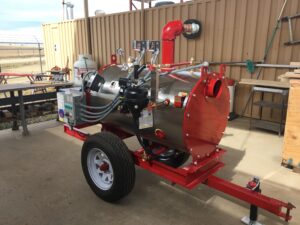
Using this device, plus a steam hose and a specialty made tarp (which we will weight down around the edges to trap the steam and define the heated area), we will treat the top layer of soil in our Greenhouse and tunnel beds, bringing the temperature in the top 2" up to 180 degrees. By heating the soil this way, we will kill sclerotia and chickweed seeds. Later we'll transplant and direct seed greens and lettuce crops in the the growing beds, for harvest from October to April. Usually the chickweed and sclerotinia would take a heavy toll on our winter crops; we sometimes lose as much as 70% of lettuce to sclerotinia in bad conditions, and spend dozens of hours each winter hand weeding chickweed out of our carrots, spinach, and greens. We'll document our activities with video and photographs, with particular emphasis on the comparison of small (5'x3') untreated areas in four different crops with the treated area.
The procedure for this project has been shaped by conversations with other growers and a considerable amount of research into the options available to control these two pests.
Update, January 2020: We purchased our steamer in July of 2019, and after thoroughly renewing it and purchasing steam hoses and a steam distribution sock, we began to use it in September. We have now steamed 90 percent of our greenhouse and high tunnel beds, and have seen wonderful results in terms of weed and disease control.
Video of steaming growing bed:
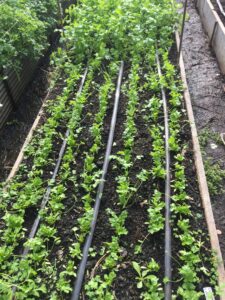
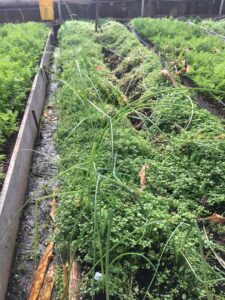
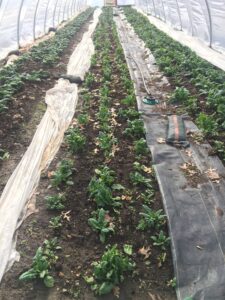
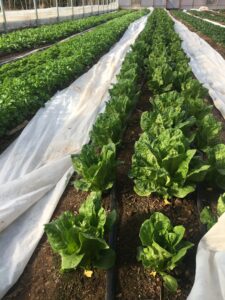
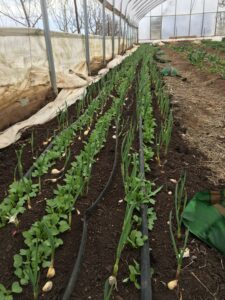
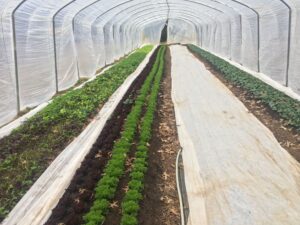
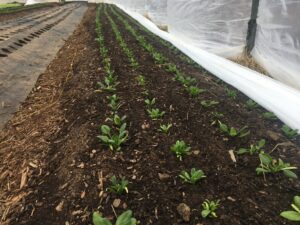
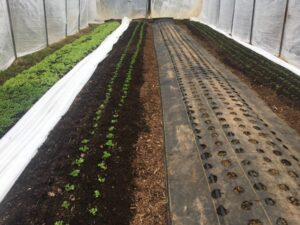
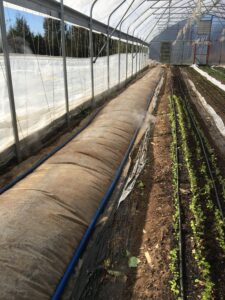
The tarp (greenhouse 6 mil poly) is inflated with steam, edges held down with 2" layflat hose filled with water.
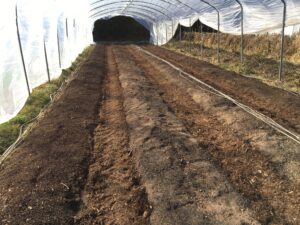
Video of steamer in action:
We have almost zero winter weeds like henbit, dead nettle, and chickweed. Where we do have them, we think they are being brought in by row cover and weed barrier that's been used in other places on the farm.
Sclerotinia is also dramatically reduced; in beds where we were previously experiencing up to 50% losses in lettuce and salad crops, we are now almost entirely disease free, and we suspect that the disease we do see is either from digging too deep when transplanting, and/or from our compost. We are going to do more trials with our compost, to see if that is one of the vectors for the Sclerotia. Specifically, in the first bed of lettuce we were able to plant after steaming, we lost three heads out of 500 to disease! In the second bed, we lost around 5 out of 300. This is a tremendous success rate.
Additionally, the spinach, salad mix, salad turnips, arugula, green garlic, carrots, and radishes we have grown are weed and disease free, and growing very well. We had some concerns about how the steamer would effect the biology of the soil, but the metrics we would use to measure this; release of organic nutrients, tilth and appearance of the soil, decomposition of organic matter, are all very positive. Additionally, we have read some research that suggests it only takes from three to four weeks for the good microbes to recolonize the soil, if it is steamed, as we are doing, to a temperature of 180f to a depth of 2".
Overall, we are really excited about these early results. We have loaned the steamer to another farm to help them address a black rot infestation, and it will be interesting to hear how that works, and it will be telling to see how long our sclerotinia levels are suppressed.
Update, May, 2021
We wanted to answer two primary questions in the second year of our SARE grant:
1. How long does the sclerotinia remain suppressed? The answer to this seems to depend a lot on the quality of the steaming job; we've learned a lot about how to seal our steam tarp, how to get best steam flow, and how to measure our temperatures. We also went through a stage of relative laxness in these categories, and have paid a price. To be specific, when I have the steamer working well (generating maximum steam flow), the tarp sealed well (either buried edges, or continuous sandbagging), and I let the steam run for a long time (like 2.5 hours or more), I can reach a temperature of 180 to a depth of 2" across the entire bed (the center heats up quite a bit faster than the edges, so measurements need to be taken at the edges). This procedure seems to suppress Sclerotinia for at least 18 months, possibly more. If, on the other hand, I don't meet these criteria, the effect only lasts for maybe six months. This fall we did not repeat steaming in many beds, and we saw a recurrence of Sclerotinia in those beds where I know I had problems with this procedure. By the same token, where we did this diligently, and the steamer worked well, we have not seen Sclerotinia yet.
2.How long does the weed-free window last? The answer to this is very similar to the first; it depends on the diligence of the farmer, and the mechanical stability of the steamer. We started to have some difficulties with the function of the steamer; it was occasionally extinguishing and failing to re-ignite, which I would often not notice for some time, and then the heat would not penetrate as deeply as we wanted. But again, when everything was working well, farmer included, we seem to have multi-year suppression of chickweed and other persistent weed problems. of course, one lax three-week period of time, and we could easily undo this by allowing one weed to go to seed; the paths were rarely as weed-free as the beds, and chickweed is a tremendous creeper. Nevertheless, it is a powerful tool in our winter and summer production model, especially in direct seeded baby greens, and spinach.
Educational & Outreach Activities
Participation Summary:
We host monthly farm walks, and these have been very well attended. On at least ten occasions, we have looked at steamed beds, and displayed the steamer, discussing our ongoing experimentation with this tool. This spring we hope to have an opportunity to do a live demonstration, with active steaming, and then an opportunity to inspect the results over time by looking at beds that have been steamed for at least 6 months. We have had average attendance at the farm walks of over 20 people, and we have had two different groups of international agriculture professionals join these events over the past 6 months.
Update, May 2021
COVID certainly had an impact on our outreach. We never held an on-farm workshop, because it never really seemed wise, and our local extension was mandating that all events be virtual. We adapted, and held the first six twilight walks of the season virtually, and posted them to youtube as well. These have been received well, and have proved a reasonable way to share information; we mentioned the steamer, and our ongoing experiments with it, in several of these video presentations, and have fielded quite a few questions from other farms about how it's working for us.
Additionally, I participated in a webinar with Rebecca Maden, a farmer who also works for the University of Vermont Extension, Andre Cantelmo, of Heron Pond Farm in New Hampshire, and several others who are steaming around the country. It was a great opportunity to discuss how their steaming is working. Rebecca is doing an ongoing study which will include detailed soil testing before and after steaming, to try to quantify the impact on soil health. This webinar was recorded, and is available to be watched on youtube, here; https://www.youtube.com/watch?v=y2i7OA2z5ok .
Later in the season we were able to host on-farm twilight walks, but by then we were starting to have problems with our steamer burner, and couldn't hold a demonstration. Nonetheless, we certainly have demonstrated the effect of the steamer to farm visitors many times, and have had lots of questions from the farming community, from emails to phone calls.
The project was featured in an article by Farm Show magazine (Volume #44, Issue #4, Page #40).
Overall, I feel like we were able to get the word out about this project pretty well, obstacles considered, and the outreach continues, I am still hosting twilight walks, and continue to talk about our steamer and show the weed and disease control.
Learning Outcomes
The take-away for our farm was simple: this is a very powerful tool, which is extremely effective. Secondarily, we were also reminded that all tools have a learning curve, and that this tool has a maintenance and repair need similar to a tractor, with high cost repairs and parts. It does have very few moving parts, and so should have a very long life, but we've had some fairly serious maintenance issues, mostly caused by age, and partly caused by forgetting to drain everything down before freezing weather. The steamer has definitely solved our Sclerotinia problem, and greatly diminished the chickweed problem. I'm not sure how the economics would work out if we were purchasing brand new, but at the $10,000 used price, it's a good investment.
We still have a lot of questions unanswered about the use of this technology;
- How is the soil biology being effected, short and long-term?
- What are the long-term economic benefits/drawbacks of using steam to control weeds and disease?
- What are ideal temperatures and depths for controlling various diseases?
- What is the most efficient way to steam? There are a variety of delivery systems being used by different farmers in the U.S., and a lot more in Europe and Canada.
- How practical is it to use steam in the field? The vast majority of the research I can find is related to protected culture, but it seems like for certain high-value crops, it could make sense to do some field steaming?
- What is the proper maintenance schedule for these machines?
And many more thoughts and questions.
Project Outcomes
The Soil Steaming Webinar we participated in was a great way to connect the few farmers across the country who are using the steaming technology on small scale flower and vegetable farms. We've stayed in touch with several of them, and are excited to continue to collaborate, so that we can learn collectively, and hopefully sidestep mistakes others have already made (like our inadequate tarp sealing, or frustrating burner issues). Collaboration like this is exactly what is so amazing about SARE, and the farming world; we all want to see each other succeed, and so are willing to share lessons we've learned. Using this approach, it seems like we move the use of this tool forward much more rapidly, since we can, collectively, learn much more together than individually.
Europe and Canada are both leaps and bounds ahead of us in the area of steaming for disease and weed control. It would do a lot for the collective knowledge of U.S. farmers to send a delegation of scientists, educators, and farmers abroad to visit some small-scale steam manufacturers, researchers, and farmers in these regions. I think a grant to send these collaborators on a knowledge seeking mission could yield a bounty of best practices, and shave decades off our learning curve here in the states. I'm certain that disease and pests are not going to get any easier to control, and accelerating our acquisition of new tools and technology to manage them sustainably seems like a good investment.